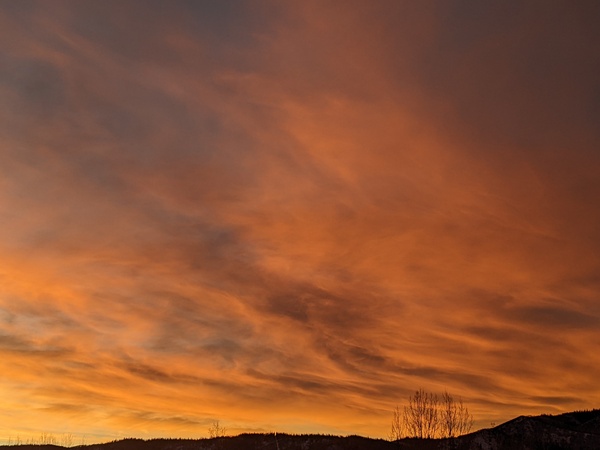Quintessential Colorado late summer weather on tap
Thursday, August 24, 2017
A building ridge of high pressure over the western states will dominate the weather in Steamboat Springs this week. Ahead of the ridge, a storm that has just crossed the west coast near Vancouver, British Columbia will travel eastward across this northern U.S. border early this weekend with little impact on our sensible weather.
Current cloudiness is caused by the remnant low pressure area over California that threatened, but did not impact, Monday’s eclipse viewing for northern Colorado (check out my account of the remarkable spectacle). Some remaining pieces of the storm are moving over our area today, but it looks like the threat of storms will stay mostly to our south for the rest of the afternoon.
While there will be some ridging tomorrow, the western ridge builds in earnest behind the eastward moving Vancouver storm on Saturday. Much drier air will contribute to warm to hot days and cool nights that are typical for late summer in Colorado.
Around midweek, some energy from the Pacific moves inland as it battles the dominant western ridge. There is uncertainty with respect to the evolution of this battle, but some increasing moisture is likely, leading to the chance of storms by midweek and lasting for a few days. At this point, anything more than possibly brief heavy rain looks unlikely before the western ridge is advertised to rebuild for the following weekend.
Some moisture midweek through the weekend
Sunday, August 20, 2017
A wave traveling over the top of a ridge of high pressure in the Gulf of Alaska has split, with the northern part of the split moving across Montana and the Dakotas tomorrow. The southern end has taken up position off the California coast, and the southwesterly flow ahead of that area of low pressure will encourage northward transport of moisture over the Steamboat Springs area around midweek and heading into next weekend.
There may be some sprinkles this afternoon, though any storms are likely to produce far more wind than rain as the lower atmosphere is quite dry and any precipitation will largely evaporate before reaching the ground.
For Monday, eclipse day, models have generally trended towards a more cloud-free solution for northern Colorado and southern Wyoming. The wave to our north will drag a couple of weak cool fronts through northern Wyoming tonight and early tomorrow. There may be some clouds ahead of and along the fronts, though current forecasts have the fronts east of Casper, Wyoming by noon on Monday. Therefore, skies will be improving through the late morning, hopefully in time for an unobstructed view of the 2017 solar spectacle.
Areas to our south may not be quite as fortunate, though models have trended drier with their noon forecast as well. There will be a chance of some storms across all of Colorado by the afternoon or early evening, most numerous to our south.
After a dry Tuesday, pieces of energy are forecast to eject northeastward from the California low, reaching our area around midweek even as a brief ridge of high pressure builds over the Rockies. There is uncertainty with respect to the interaction between the low to our west and the ridge of high pressure over our area, with models trending weaker with the surges of moisture and energy. The end result is an uptick in chances for storms starting around Wednesday and lasting into the first half of the weekend, though the threat of more than brief heavy rain currently looks small.
By around Thursday, a strong storm crosses the southern British Columbia coast and travels along the U.S. - Canadian border over the weekend. This will sweep the ridge of high pressure and the California low eastward, with the unsettled weather ending by mid-weekend and being replaced by Colorado’s quintessential late summer weather with warm, dry days and cool nights.
Weekend warming followed by increasing work week moisture
Thursday, August 17, 2017
A surge of cool air moving southward from the North Pole has created a wave in the polar jet stream that is currently passing through Montana and the Dakotas A weak cool front associated with this wave will be dragged through the Steamboat Springs area overnight with little sensible effects on our weather.
The western ridge rebuilds behind the wave, bringing warmer temperatures and drier air for the weekend, with only a small chance of afternoon storms. Concurrently, another surge of cooler air from the northern latitudes produces an additional wave that crosses the southern British Columbia coast on Friday. This will temper the strength of the ridge as the bulk of the storm again travels north of our area.
Notably, part of that wave splits and forms a trough of low pressure off the California coast that loiters there for at least part of the work week. As this trough forms over the weekend, the upper level flow backs from the northwest to the southwest, and mid and upper level moisture increases by late in the weekend, especially for areas to our south.
This could threaten the viewing of the 2017 solar eclipse on Monday, though right now it appears there is enough dry air lurking to our north to keep the clouds at bay for the Steamboat Springs event. Areas further south might not be as fortunate. And for those traveling north to Wyoming to view the spectacle, the chances for mostly cloud-free viewing are higher.
The western ridge is forecast to amplify further through the work week, bringing even warmer temperatures to the area. While models eventually move the California trough eastward, attendant with good chances for rain, the European ECMWF has trended slower than the American GFS. The slower solution allows the western ridge to rebuild, and the ECMWF then has the trough lifting northwest of our area, keeping conditions much drier than the American model for the end of the work week.
Active weather decreases midweek followed by weekend warming
Monday, August 14, 2017
The Steamboat Springs area is under an active weather regime for August as the polar jet stream dips a bit further south than average for this time of year. A trough of low pressure that was over the West Coast this past weekend is splitting as it moves inland even as additional cool air from the North Pole moves southward across Alaska and takes its place over the next week.
There will be continued chances of storm for today and Tuesday, including the overnight hours, as several cool fronts from the northern part of the split interact with energy ejecting out of the trailing southern part of the split.
The active weather diminishes around Wednesday as the late summer western ridge rebuilds, though another trough from the Gulf of Alaska is forecast move across the northern states late in the work week and limit the strength of the ridge. Current forecasts drag another weak cool front through the area Friday morning, with the western ridge growing stronger over the weekend and bringing much warmer temperatures to our area.
There should be enough moisture, however, for a chance of afternoon storms through the rest of the work week and extending into the weekend before another Gulf of Alaska storm approaches the West Coast mid-weekend and splits like the past several storms. Numerical models currently advertise a similar evolution for that storm, with the main part traveling north of our area early next week and the southern part taking up residence off the coast of California.
Weather slowly turns more seasonable for the week ahead
Thursday, August 10, 2017
A ridge of high pressure in British Columbia is sandwiched between a strong storm in the Gulf of Alaska and a broad trough of low pressure over the eastern two thirds of the country. Energy traveling southward from western Canada along the east side of the ridge has brought a series of cool fronts through the Steamboat Springs area this past week. Additionally, a weak area of low pressure off the northern California coast has supplied a steady stream of moisture for our area, and this combined with the cool fronts has brought significant moisture to the Yampa Valley.
Additional cold air dropping into the Gulf of Alaska first elongates the storm located there southward before moving it eastward early in the next work week. As this happens, the old low pressure area off the northern California coast gets kicked east-northeastward on Friday. Brief ridging occurs over our area on Friday ahead of that leading to a slight chance of afternoon storms.
However, pieces of the old California low will move over our area on Saturday and Sunday, and combine with a couple more surges of cool air from the north to increase the chance of storms for both days again.
There is a fair bit of uncertainty for early next week with respect to the evolution of the Gulf of Alaska storm. At one point it looked like drier westerly flow would overspread the area as the storm traveled to our north, but now there are indications that some of the storm will be left behind off the California coast. It is not clear whether our area will experience a moist southwest flow, which would produce storms for Monday and Tuesday, or a drier westerly flow.
For what it’s worth, models currently agree that the midweek period will be drier, though the following weekend may be affected by energy left off the California coast that eventually propagates inland.








